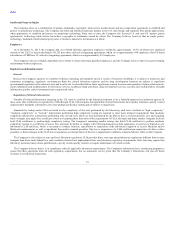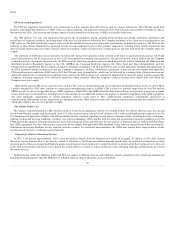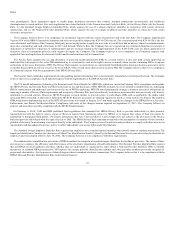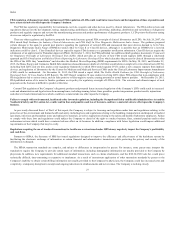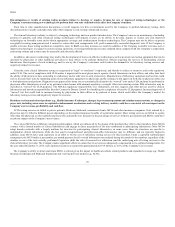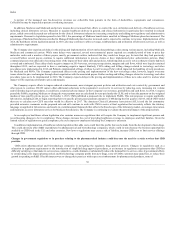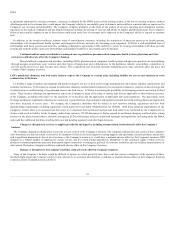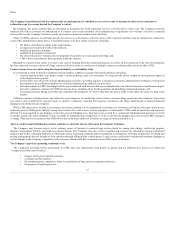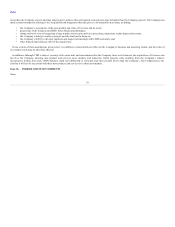LabCorp 2015 Annual Report Download - page 29
Download and view the complete annual report
Please find page 29 of the 2015 LabCorp annual report below. You can navigate through the pages in the report by either clicking on the pages listed below, or by using the keyword search tool below to find specific information within the annual report.
Index
From time to time, manufacturers discontinue or recall reagents, test kits or instruments used by the Company to perform laboratory testing. Such
discontinuations or recalls could adversely affect the Company’s costs, testing volume and revenue.
The clinical laboratory industry is subject to changing technology and new product introductions. The Company’s success in maintaining a leadership
position in genomic and other advanced testing technologies will depend, in part, on its ability to develop, acquire or license new and improved
technologies on favorable terms and to obtain appropriate coverage and reimbursement for these technologies. The Company may not be able to negotiate
acceptable licensing arrangements and it cannot be certain that such arrangements will yield commercially successful diagnostic tests. If the Company is
unable to license these testing methods at competitive rates, its R&D costs may increase as a result. In addition, if the Company is unable to license new or
improved technologies to expand its esoteric testing operations, its testing methods may become outdated when compared with the Company’s competition
and testing volume and revenue may be materially and adversely affected.
In addition, advances in technology may lead to the development of more cost-effective technologies such as point-of-care testing equipment that can be
operated by physicians or other healthcare providers in their offices or by patients themselves without requiring the services of freestanding clinical
laboratories. Development of such technology and its use by the Company’s customers could reduce the demand for its laboratory testing services and
negatively impact its revenues.
Currently, most clinical laboratory testing is categorized as “high” or “moderate” complexity, and thereby is subject to extensive and costly regulation
under CLIA. The cost of compliance with CLIA makes it impractical for most physicians to operate clinical laboratories in their offices, and other laws limit
the ability of physicians to have ownership in a laboratory and to refer tests to such a laboratory. Manufacturers of laboratory equipment and test kits could
seek to increase their sales by marketing point-of-care laboratory equipment to physicians and by selling test kits approved for home or physician office use
to both physicians and patients. Diagnostic tests approved for home use are automatically deemed to be “waived” tests under CLIA and may be performed in
physician office laboratories as well as by patients in their homes with minimal regulatory oversight. Other tests meeting certain FDA criteria also may be
classified as “waived” for CLIA purposes. The FDA has regulatory responsibility over instruments, test kits, reagents and other devices used by clinical
laboratories and has taken responsibility from the Centers for Disease Control for classifying the complexity of tests for CLIA purposes. Increased approval of
“waived” test kits could lead to increased testing by physicians in their offices or by patients at home, which could affect the Company’s market for
laboratory testing services and negatively impact its revenues.
LCD's testing services are billed to private patients, Medicare, Medicaid, commercial clients, MCOs and other insurance companies. Tests ordered by a
physician may be billed to different payers depending on the medical insurance benefits of a particular patient. Most testing services are billed to a party
other than the physician or other authorized person who ordered the test. Increases in the percentage of services billed to government and MCOs could have
an adverse impact on the Company’s net revenues.
The various MCOs have different contracting philosophies, which are influenced by the design of the products they offer to their members. Some MCOs
contract with a limited number of clinical laboratories and engage in direct negotiation of the rates reimbursed to participating laboratories. Other MCOs
adopt broader networks with a largely uniform fee structure for participating clinical laboratories; in some cases, those fee structures are specific to
independent clinical laboratories while the fees paid to hospital-based and physician-office laboratories may be different, and are typically higher. In
addition, some MCOs have used capitation in an effort to fix the cost of laboratory testing services for their enrollees. Under a capitated reimbursement
arrangement, the MCO makes a per member, per month payment for all covered laboratory tests rendered during the month for the members, regardless of the
number or cost of the tests actually performed. Capitation shifts the risk of increased test utilization (and the underlying mix of testing services) to the
clinical laboratory provider. The Company makes significant efforts to ensure that its services are adequately compensated in its capitated arrangements. For
the year ended December 31, 2015, such capitated contracts accounted for approximately $219.9 million, or 2.6%, of the Company's net revenues.
The Company's ability to attract and retain MCOs is critical given the impact of healthcare reform, related products and expanded coverage (e.g., Health
Insurance Exchanges and Medicaid Expansion) and evolving delivery models (e.g., ACOs).
29


